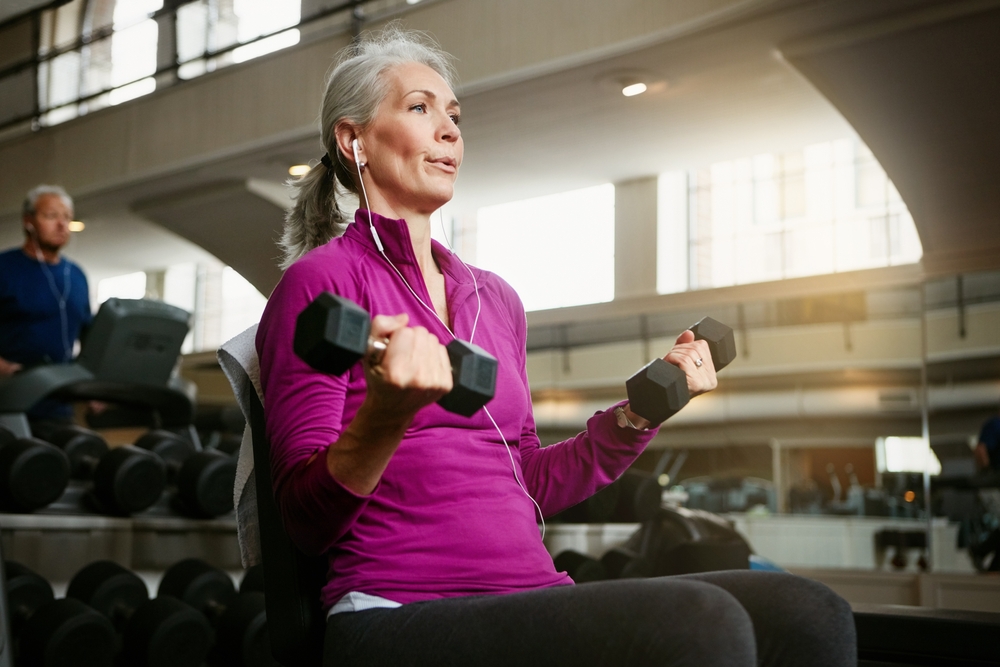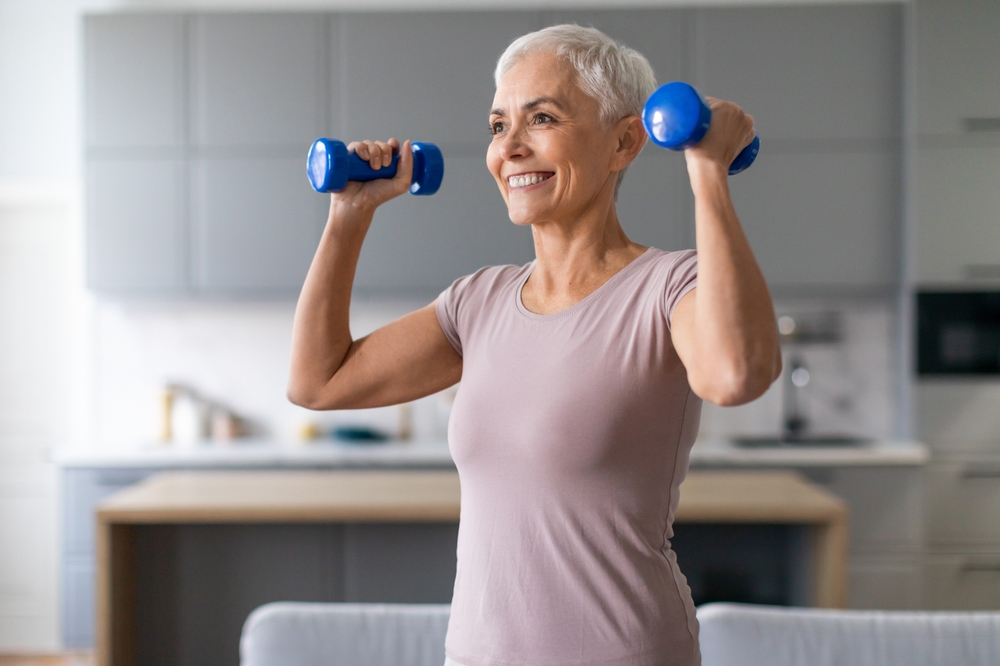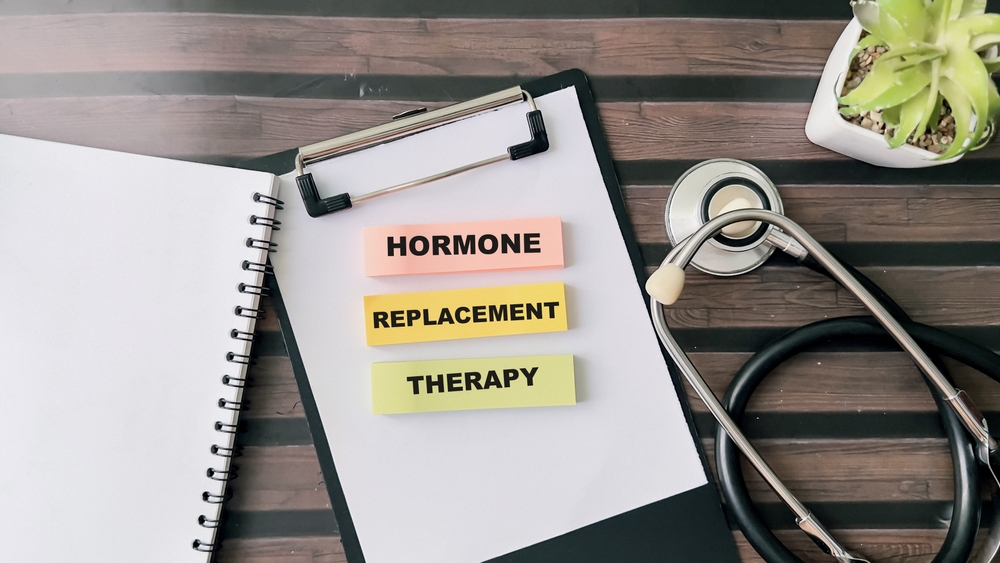Quick Summary
- Strength training slows age-related muscle loss and supports everyday strength, helping women stay active and independent.
- The training also increases feel-good hormones, easing anxiety, depression, and mood swings common during menopause.
- Strength training helps lower blood pressure, improve insulin sensitivity, and protect against heart disease and diabetes.
- Work with a certified trainer if possible, listen to your body, and progress at your own pace to avoid injury and build confidence.
- Before starting strength training, consult your doctor—especially if you have joint pain, chronic conditions, or other health concerns.
Menopause is a natural stage in every woman's life. While it brings many physical and emotional changes, such as weight gain, muscle loss, mood swings, and night sweats, it's also an opportunity to prioritize health in new ways.
One of the most effective and empowering tools during this transition is strength training. Often misunderstood as something only for bodybuilders or athletes, strength training (also known as resistance training) offers a wide variety of benefits, especially for women going through menopause. From maintaining muscle mass and bone density to improving mental health, the rewards are too valuable to ignore.
In this article, we'll explore how strength training for menopause supports women during this phase of life, and how you can start, even if you've never lifted a dumbbell before.

What Happens During Menopause?
Before we jump into the benefits, let's understand what happens to your body during menopause. Menopause typically occurs between the ages of 45 and 55.
It marks the end of menstruation and fertility, and is officially diagnosed after 12 consecutive months without a period. The years leading up to it (known as perimenopause) can be equally challenging. Hormonal shifts, especially drops in estrogen, can cause a range of things such as:
- Hot flashes and night sweats
- Sleep disturbances
- Mood swings or depression
- Weight gain and fat accumulation
- Loss of muscle and bone mass
- Joint pain
- Reduced energy levels
These changes can feel overwhelming, but physical activity, particularly strength training, can make a big difference.
What Is Strength Training?
Strength training, or resistance training, includes any exercise that uses resistance to build muscle strength, lean body mass, and bone health. Resistance can come from:
- Free weights (like dumbbells or barbells)
- Resistance bands
- Your own body weight (such as squats, push-ups, or planks)
- Machines in a gym
Remember, it's not about getting bulky; it's about becoming stronger, more stable, and more resilient.
Strength Training For Menopause: How It Benefits Women Going Through It
Menopause brings several changes - some expected, others surprising. From hot flashes to mood swings, it can feel like your body works against you.
Luckily, strength training can help. Not only does it benefit athletes and fitness enthusiasts, but it's also increasingly beneficial for women who want to stay strong, healthy, and confident. Without further ado, here are some ways lifting weights or doing resistance exercises can support your health during this stage of life.
Preserves And Builds Lean Muscle Mass
One of the most noticeable changes during menopause is muscle loss. Adults lose about 3-8% of their muscle mass per decade after age 30 [1], and menopause accelerates this process. Here's where lifting weights or using resistance exercises makes a big difference:
- Increases muscle strength and size (also known as muscle growth)
- Maintains or improves lean muscle mass
- Supports better physical function and functional fitness in everyday life
Even basic dynamic resistance workout that targets major muscle groups, such as squats, lunges, and the bench press, can help women stay strong and independent as they age.
Tip: A personal trainer can help create a safe and effective exercise program tailored to your fitness level and goals.
Improves Body Composition And Manages Weight
Many women experience changes in body composition during menopause [2]. They gain fat and lose muscle mass, which may lead to a higher body mass index (BMI) and lower metabolism. Strength training helps women:
- Reduce fat mass
- Increases lean body mass
- Stabilizes total body mass even as hormone levels shift
- Prevents or slows down weight gain
While many try to lose weight with aerobic exercise, if you combine it with resistance training, chances are it yields better long-term results. Strength training builds muscle, which in turn burns more calories, even at rest.
Supports Bone Health And Prevents Bone Loss
Declining estrogen levels often lead to bone loss and a reduction in bone mineral density (BMD). This significantly increases the risk of fractures. Here are a few ways strength training can help:
- It increases bone density and strength
- Helps minimize bone loss
- Enhances bone mineral density changes, especially in the spine and hips
- Improves dynamic balance and reduces falls
Numerous randomized controlled trials and systematic reviews show that resistance training is effective in increasing bone density [3], particularly when performed at moderate or greater intensity.
Note: Exercises such as deadlifts, squats, and weight-bearing movements create enough stress on the bones to stimulate growth.
Boosts Mental Health And Reduces Mood Swings
Hormonal changes during menopause can lead to anxiety, depression, and mood swings. Fortunately, exercise interventions, especially strength training, have been shown to improve:
- Mental health
- Emotional regulation
- Self-esteem and confidence
- Symptoms of sexual dysfunction
Physical activity increases endorphins - the "feel-good" hormones - and lowers cortisol, the stress hormone [4]. This not only improves mood but also helps women handle menopausal symptoms more effectively.
Fem Excel provides personalized care to help you understand the emotional changes your body goes through. Our team takes the time to listen, hear, and guide you toward a treatment plan that fits your needs. Whether you're feeling overwhelmed, anxious, or simply off-balance, we've got your back.
Enhances Physical Function And Independence
Loss of strength, mobility, and coordination can make everyday life more challenging for menopausal women. With Strength training, you can:
- Improve upper body strength and grip
- Support better joint health, easing joint pain
- Enhance functional fitness - the ability to do daily tasks without fatigue
- Help maintain independence as you age
Ensure that you target all major muscle groups, as this ensures a balanced exercise training routine. For example:
- Lower body: squats, lunges
- Upper body: bench press, rows
- Core: planks, twists
Minimizes The Risk Of Chronic Diseases
Menopause is linked to an increased risk of chronic diseases such as heart disease [5], type 2 diabetes, and osteoporosis. A well-designed strength training program can lower these risks by:
- Reducing body fat and improving insulin sensitivity
- Lowering blood pressure and improving cholesterol levels
- Supporting healthy body composition and metabolism
Moreover, strength training improves body mass ratios and props overall women's health during the menopause transition.
Hormones, Protein, And Muscle Retention
The decline in estrogen, paired with rising high follicle-stimulating hormone (FSH), affects how efficiently the body builds and retains lean muscle mass. That's why pairing strength training with proper protein intake is essential.
A protein-rich diet supports:
- Muscle growth and repair
- Greater gains from training volume
- Recovery from high-intensity interval training and resistance training

Getting Started With Strength Training
The good news is that you don't need to join a gym or lift heavy weights to see outcomes. Strength training is highly adaptable and can be done at home, at the gym, or anywhere that feels comfortable for you. Below is a simple guide to help you get started safely and effectively.
Start With Bodyweight And Resistance Bands
If you're new to strength training, starting with your body weight and resistance bands is a smart and gentle way to ease into it. These tools are low-impact, inexpensive, and easy to use at home.
These exercises help you build a foundation of strength while learning how to move properly. They also reduce the risk of injury by encouraging control and balance. Movements such as squats and lunges teach you how to bend and lift safely, which supports functional fitness in daily life. Starting slow gives you time to understand your body and build confidence.
Listed below are some examples of beginner-friendly exercises you can perform:
- Squats - strengthen your legs, hips, and core
- Lunges - build lower body strength and improve dynamic balance
- Push-ups (start on your knees if needed) - boost upper body and core strength
- Planks - improve posture and abdominal control
Using resistance bands adds tension to these moves, helping you create resistance and stimulate muscle growth without the need for heavy weights.
Incorporate Free Weights Or Weight Machines
Once you feel comfortable with bodyweight exercises, you can progress by adding free weights, such as dumbbells or kettlebells, or using weight machines at a gym.
Adding resistance provides progressive overload, which is key for building lean muscle mass and increasing bone density - two critical goals during the menopausal transition. You can train the major muscle groups more directly using weights. This allows for more variety and personalized routines based on your goals.
Some examples of weighted exercises include:
- Dumbbell rows - strengthen your back and arms
- Bench press - target the chest and shoulders
- Leg press machine - work the thighs and glutes with support
Start light, and focus on technique and control. As your strength improves, you can gradually increase the weight you lift.
Work With A Personal Trainer
If you're new to strength training - or even if it's just been a while - a personal trainer can be incredibly helpful.
- Why it's useful: Trainers can teach you correct form, introduce you to new equipment, and make sure you're training safely. This is especially important if you're dealing with joint pain, past injuries, or other menopausal symptoms.
- Personalized programs: A trainer can customize a routine based on your fitness level, health status, and goals. For example, if you want to reduce fracture risk or prevent muscle loss, your trainer can include exercises to support bone health and muscle strength.
You don't have to work with a trainer forever - even a few sessions can make a change.
Focus On Training Major Muscle Groups
When building your weekly routine, it's important to work all the major muscle groups. This ensures full-body strength and functional movement. Train 2-3 times per week. This frequency is ideal for building strength while allowing time for rest and recovery.
Make sure to include exercises for:
- Legs and hips (squats, lunges)
- Back (rows, lat pulldowns)
- Chest (push-ups, bench press)
- Shoulders (overhead press)
- Arms (bicep curls, triceps dips)
- Core (planks, bridges)
These exercises can help improve upper body strength, posture, balance, and everyday movements like lifting, bending, or getting up from a chair.
Gradually Increase Training Volume
To continue making progress and avoid plateaus, you'll want to slowly increase your training volume - this means the total amount of work your muscles are doing.
- Add sets, reps, or weight over time: For example, if you're doing two sets of 10 reps with a light weight, try three sets, or use a slightly heavier weight as you get stronger.
- Listen to your body: While it's important to challenge yourself, it's equally important to rest when needed. Recovery allows your muscles to rebuild stronger. Don't ignore signs of fatigue or soreness that linger more than a couple of days.
Precautions And Professional Guidance
While strength training is incredibly beneficial for menopausal women, it's important to approach it safely, especially if you're new to exercise or dealing with health concerns.
Before you start any exercise program, talk to your doctor. This is particularly important if you have chronic diseases, joint pain, or other medical conditions. Your doctor can help you understand what level of activity is safe and effective for you.
In addition, consider working with a personal trainer, even for a few sessions. A certified trainer can teach you proper form, help you target the right muscle groups, and create a routine that matches your fitness level. This guidance can reduce your risk of injury and boost your confidence.
Moreover, notice how your body feels. If you experience pain, dizziness, or unusual fatigue, stop and rest. Progress at your own pace. After all, starting slow is better than pushing too hard and getting hurt.
And remember: any time is a good time to start. Many women start strength training in their 40s, 50s, or even 60s and see incredible benefits. With the right support and mindset, you can safely build strength, improve your health, and feel empowered at any age.
Conclusion
Menopause doesn't have to mean decline; it can be the start of a new, stronger chapter.
With strength training for menopause, women can take proactive steps to maintain bone health, improve muscle strength, boost mental health, and support a healthy body composition. It's never too late to start. Whether you're in your 50s or beyond, strength training can help you feel energized, empowered, and resilient during menopause and beyond.
So, pick up those free weights, stretch those muscles, and discover the transformative power of strength, both inside and out. At Fem Excel, we understand how hormonal changes can affect your body, mood, and overall well-being, whether you're navigating menopause, dealing with PCOS, or facing other hormone-related issues.
That's why our expert hormone specialists offer safe, personalized, and effective treatment options tailored to your unique needs. Our goal is to help you manage symptoms, restore balance, and feel more like yourself again - strong, confident, and back in control of your health.
References
1. Volpi, E., Nazemi, R., & Fujita, S. (2004). Muscle tissue changes with aging. Current opinion in clinical nutrition and metabolic care, 7(4), 405-410. https://doi.org/10.1097/01.mco.0000134362.76653.b2
2. Fenton A. (2021). Weight, Shape, and Body Composition Changes at Menopause. Journal of mid-life health, 12(3), 187-192. https://doi.org/10.4103/jmh.jmh_123_21
3. Hong, A. R., & Kim, S. W. (2018). Effects of Resistance Exercise on Bone Health. Endocrinology and metabolism (Seoul, Korea), 33(4), 435-444. https://doi.org/10.3803/EnM.2018.33.4.435
4. Hossain, M. N., Lee, J., Choi, H., Kwak, Y. S., & Kim, J. (2024). The impact of exercise on depression: how moving makes your brain and body feel better. Physical activity and nutrition, 28(2), 43-51. https://doi.org/10.20463/pan.2024.0015
5. Ryczkowska, K., Adach, W., Janikowski, K., Banach, M., & Bielecka-Dabrowa, A. (2022). Menopause and women's cardiovascular health: is it really an obvious relationship?. Archives of medical science: AMS, 19(2), 458-466. https://doi.org/10.5114/aoms/157308






